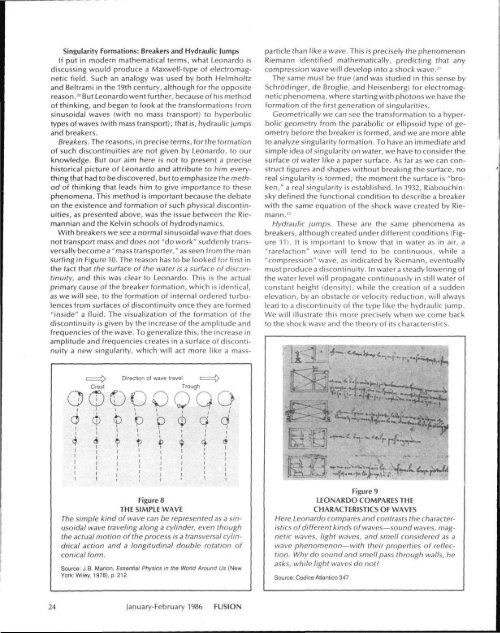And Hypersonic Flight
And Hypersonic Flight
And Hypersonic Flight
You also want an ePaper? Increase the reach of your titles
YUMPU automatically turns print PDFs into web optimized ePapers that Google loves.
Singularity Formations: Breakers and Hydraulic lumpsIf put in modern mathematical terms, what Leonardo isdiscussing would produce a Maxwell-type of electromagneticfield. Such an analogy was used by both Helmholtzand Beltrami in the 19th century, although for the oppositereason. But Leonardo went further, because of his methodof thinking, and began to look at the transformations fromsinusoidal waves (with no mass transport) to hyperbolictypes of waves (with mass transport); that is, hydraulic jumpsand breakers.Breakers. The reasons, in precise terms, forthe formationof such discontinuities are not given by Leonardo, to ourknowledge. But our aim here is not to present a precisehistorical picture of Leonardo and attribute to him everythingthat had to be discovered, but to emphasize the methodof thinking that leads him to give importance to thesephenomena. This method is important because the debateon the existence and formation of such physical discontinuities,as presented above, was the issue between the Riemannianand the Kelvin schools of hydrodynamics.With breakers we see a normal sinusoidal wave that doesnot transport mass and does not "do work" suddenly transversallybecome a "mass transporter," as seen from the mansurfing in Figure 10. The reason has to be looked for first inthe fact that the surface of the water is a surface of discontinuity,and this was clear to Leonardo. This is the actualprimary cause of the breaker formation, which is identical,as we will see, to the formation of internal ordered turbulencesfrom surfaces of discontinuity once they are formed"inside" a fluid. The visualization of the formation of thediscontinuity is given by the increase of the amplitude andfrequencies of the wave. To generalize this, the increase inamplitude and frequencies creates in a surface of discontinuitya new singularity, which will act more like a mass-particle than like a wave. This is precisely the phenomenonRiemann identified mathematically, predicting that anycompression wave will develop into a shock wave. 2 'The same must be true (and was studied in this sense bySchrodinger, de Broglie, and Heisenberg) for electromagneticphenomena, where starting with photons we have theformation of the first generation of singularities.Geometrically we can see the transformation to a hyperbolicgeometry from the parabolic or ellipsoid type of geometrybefore the breaker is formed, and we are more ableto analyze singularity formation. To have an immediate andsimple idea of singularity on water, we have to consider thesurface of water like a paper surface. As far as we can constructfigures and shapes without breaking the surface, noreal singularity is formed; the moment the surface is "broken,"a real singularity is established. In 1932, Riabouchinskydefined the functional condition to describe a breakerwith the same equation of the shock wave created by Riemann.22Hydraulic jumps. These are the same phenomena asbreakers, although created under different conditions (Figure11). It is important to know that in water as in air, a"rarefaction" wave will tend to be continuous, while a"compression" wave, as indicated by Riemann, eventuallymust produce a discontinuity. In water a steady lowering ofthe water level will propagate continuously in still water ofconstant height (density), while the creation of a suddenelevation, by an obstacle or velocity reduction, will alwayslead to a discontinuity of the type like the hydraulic jump.We will illustrate this more precisely when we come backto the shock wave and the theory of its characteristics.Figure 8THE SIMPLE WAVEThe simple kind of wave can be represented as a sinusoidalwave traveling along a cylinder, even thoughthe actual motion of the process is a transversal cylindricalaction and a longitudinal double rotation ofconical form.Source: J.B. Marion, Essential Physics in the World Around Us (NewYork: Wiley, 1978), p. 212.Figure 9LEONARDO COMPARES THECHARACTERISTICS OF WAVESHere Leonardo compares and contrasts the characteristicsof different kinds of waves—soundwaves, magneticwaves, light waves, and smell considered as awave phenomenon—with their properties of reflection.Why do sound and smell pass through walls, heasks, while light waves do not?Source: Codice Atlantico 347,24 January-February 1986 FUSION
















